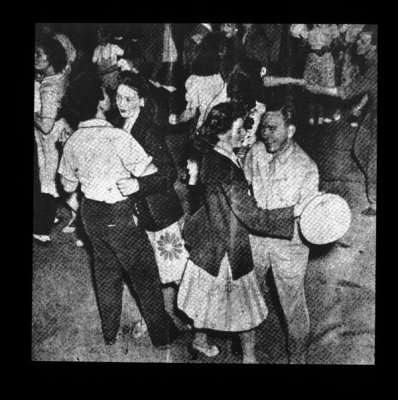On July 2, 1942, the Albright Art Gallery, in conjunction with the Buffalo Parks Department, sponsored an open-air dance at the museum, the first in a series of concerts and dances meant to provide entertainment during World War II.
In a description found in the Buffalo Fine Arts Academy’s Gallery Notes from July 1942, The Buffalo Evening News offered this poetic report about the event:
“One of the moves to provide the public with tire-saving, near-at-hand means of recreation received an auspicious start Wednesday evening as several thousand persons filled the areas adjacent to the Albright Art Gallery for a concert and street dance held in co-operation with the Gallery by the Parks Department. The program, except for the dance portion, which resulted in some lively ‘rug-cutting’ on the stone play facing Lincoln Parkway, was marked by an atmosphere of country-like tranquility. Reclining comfortably in the grassy terrace or sitting on chairs or stone benches on the plaza, the crowd contentedly drank in the cool evening air and the equally refreshing and peaceful airs by the Buffalo Civic Orchestra. An airplane droned overhead … The clock in the State Teachers College [SUNY Buffalo State College] chimed the quarter-hour … Canoes seemingly skimmed over [Hoyt] Park Lake in waltz-time through columns of reflected lamp-light. From the bandstand came the music of Nicolai, German, Ketelbey, Strauss and Friml, soft and lulling for the most part. Sometimes the cry of, 'Johnny, get away from the fountain or you’ll fall in’ would be heard. As darkness deepened, the four spotlights focused on the bandstand grew brighter in contrast, like a movie sunrise, and the upraised brass instruments and the phalanx of violin bows, moving up and down, alone stood out. At the end of the first hour Conductor Jan Pawel Wolanek stepped down and Parks Commissioner Ulinski came to the microphone and explained the aim of the city is to encourage outdoor concerts and dances such as prevailed in Europe before the war.”
The description in Gallery Notes continued:
“Refreshments sold from stands on the Gallery terrace and in the street below added to the charm of the scene which will be enhanced in the future by the use of tables and chairs. Picnic parties are urged to bring their suppers and listen to the music at the lake-side, where park tables and benches will be provided.
The Gallery, now on the new wartime summer schedule of being open from 2 to 10 pm daily, provides informal talks on the collections by a member of staff every Tuesday, Wednesday, and Friday at 8:30 pm during July and August.”
